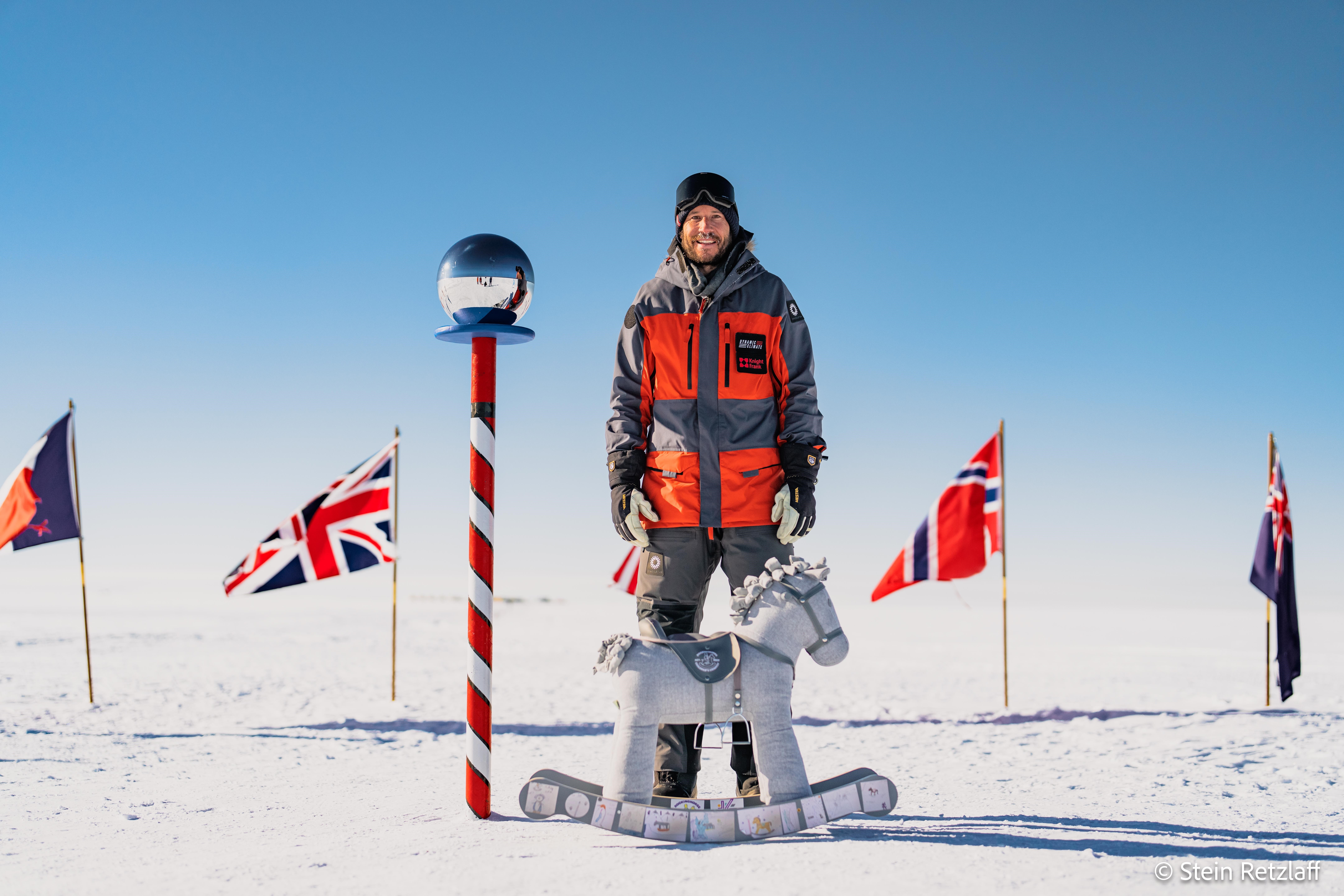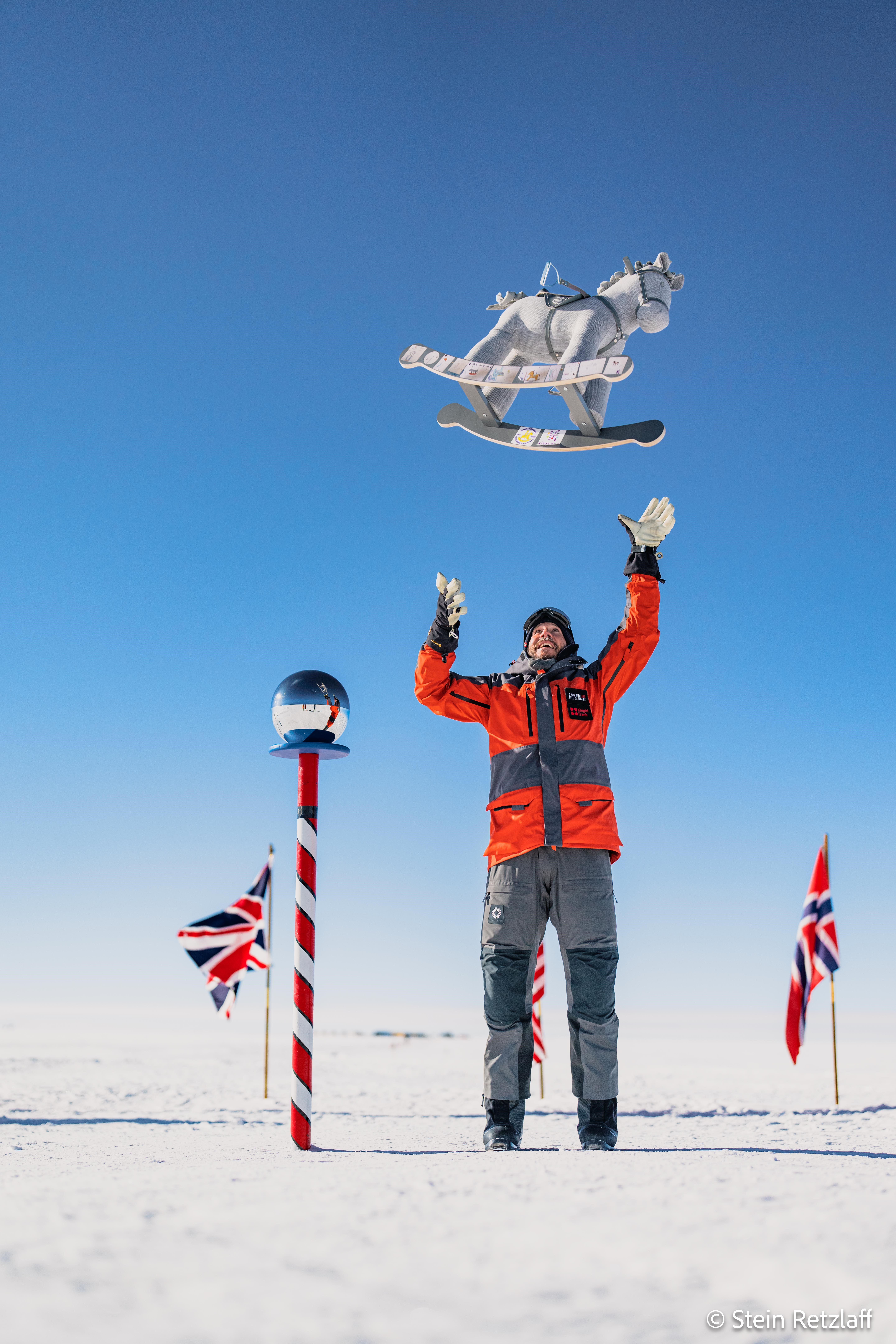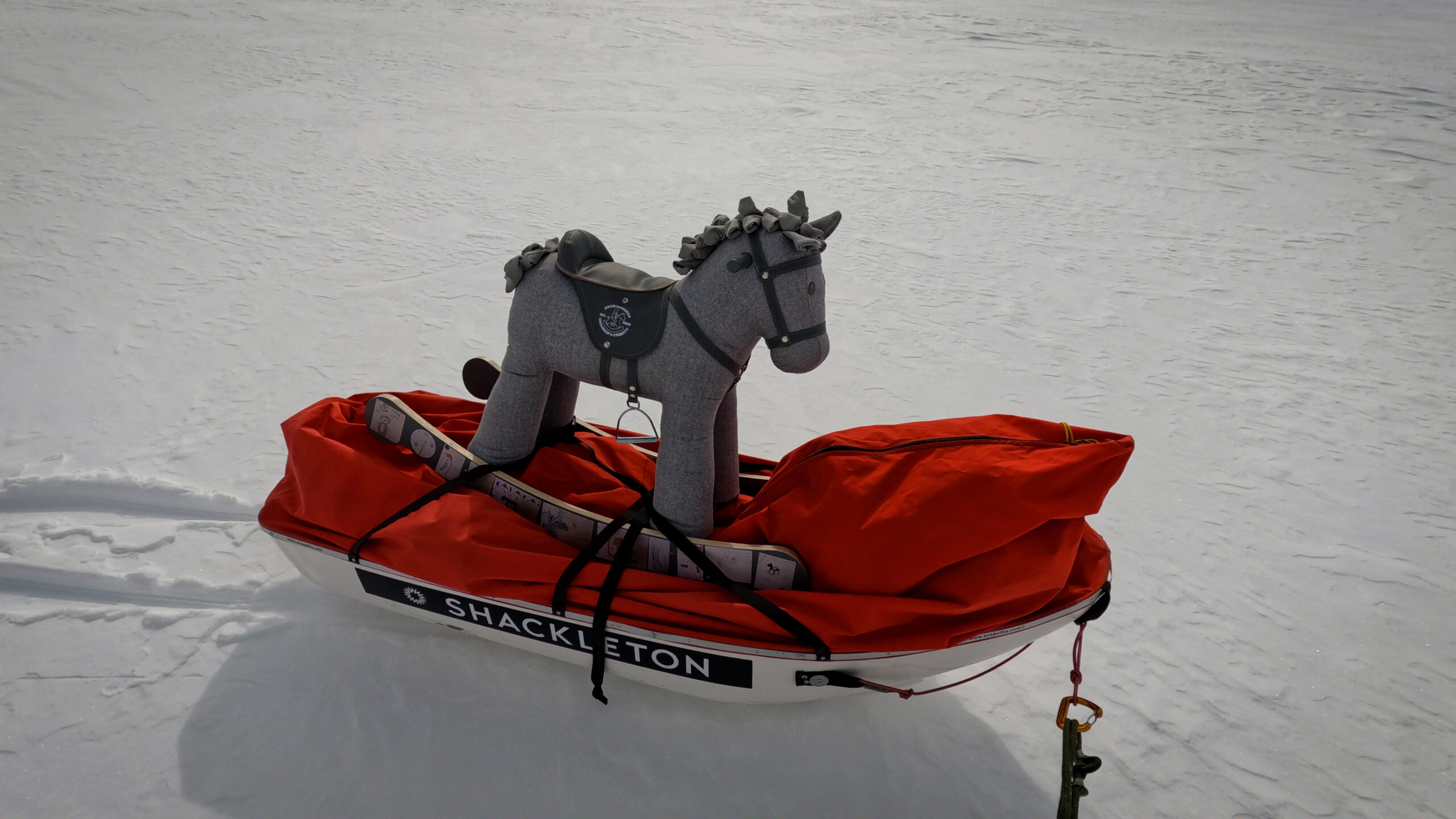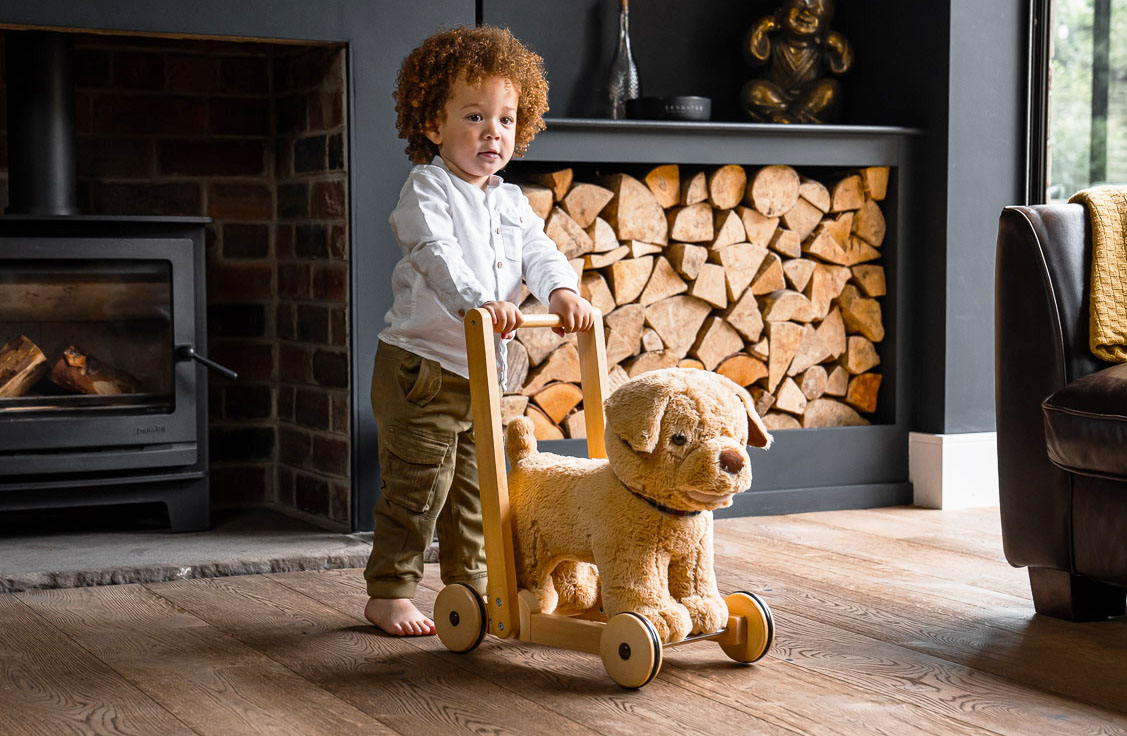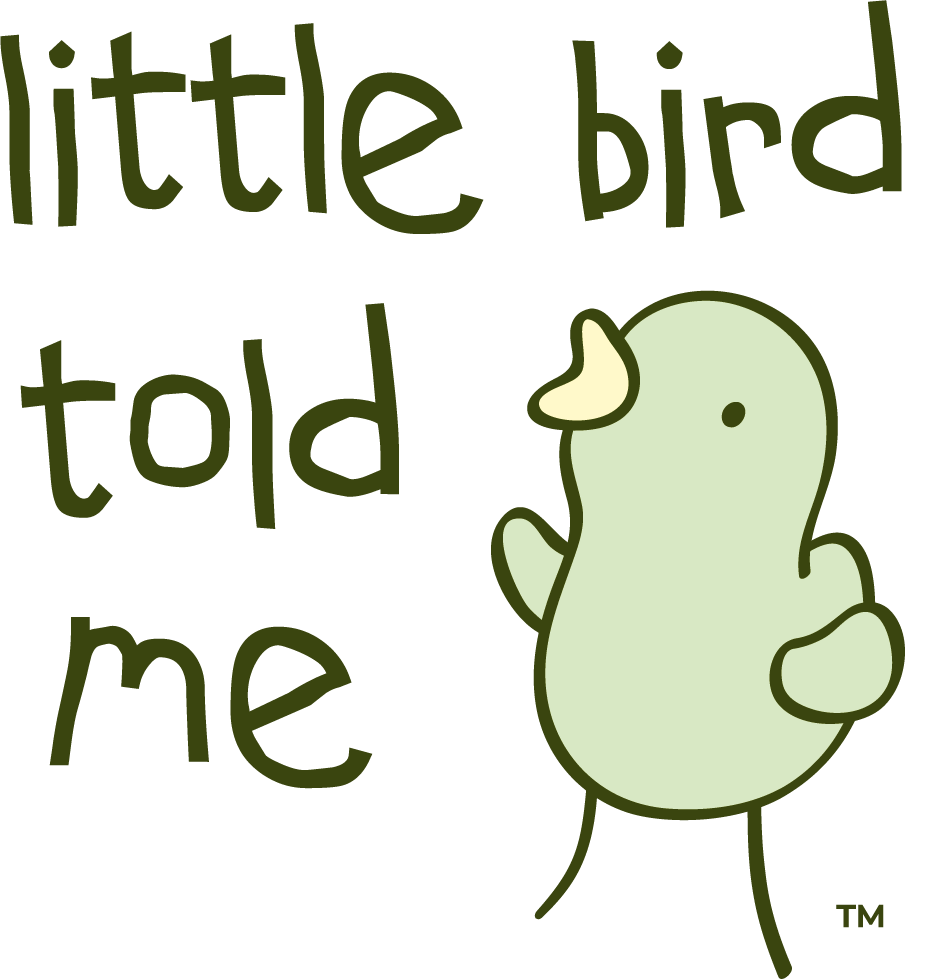A Tale of Courage and Compassion: Stirling’s South Pole Adventure!
In a world where dreams shimmer with the possibility of reality, we’re thrilled to share the awe-inspiring journey of Josh Braid, an adventurer with a heart as bold as the Antarctic winds. With Stirling Rocking Horse on his sledge, Josh embarked on a monumental expedition to the South Pole, all in the spirit of charity and legacy. We extend our heartfelt congratulations to Josh Braid for not only embarking on the expedition of a lifetime but also for encouraging dreams of adventure, and generosity, while raising funds for two worthy causes.
Chasing Dreams Across Icy Frontiers for Charity
Inspired by the adventurous spirit of his great uncle’s 1961 expedition, Josh set out not only to follow in his historic footsteps but also to raise funds for two noble causes. His goal is to raise £50,000 and he is well underway with this!
Rockinghorse Children’s Charity supports sick and disabled children across Sussex. They support babies, children and young people, along with their families, at The Royal Alexandra Children’s Hospital and The Trevor Mann Baby Unit in Brighton and all of the specialist children’s wards and baby units throughout Sussex. To find out more, visit them at rockinghorse.org.uk.
Kidscape is an award-winning bullying prevention charity. They support children and their families across England and Wales to challenge bullying and to have happy, healthy relationships. To find out more, visit them at kidscape.org.uk.
Inspiring the Next Generation of Dreamers
Amidst the whirlwind of preparations and the expedition itself, Josh made time to visit schools, sharing his tale and encouraging children to embark on adventures of their own. In a stroke of creative genius, he initiated a contest inviting children to design artwork for Stirling’s rocking rails—a contest that not only celebrated imagination but also raised additional funds for his causes. The children also renamed our horse – Rocky became his new name!
A Story That Captured Hearts
Josh’s epic quest caught the attention of locals and those further afield, leading to captivating interviews where he shared his daring ambitions and heartfelt mission. Media outlets like ITV and BBC shared his story, spreading the word of this remarkable trek across the icy expanse with a rocking horse in tow.
The Journey of a Lifetime
Departing on the 14th of December, Josh and Rocky / Stirling set off from Heathrow, bound for the icy realms of Antarctica. By Christmas Eve, Josh had scaled Mt. Vinson, overcoming the challenges of the wild with unwavering determination. He then pulled Rocky / Stirling Rocking Horse across Antarctica… And on the 13th of January 2024, they reached the South Pole – a triumph of spirit and teamwork! This also marked Stirling as the first rocking horse to brave such a journey! For those interested in reading Josh’s remarkable story, we have pasted a copy of his journal at the end of this page.
Continuing the Adventure
Josh’s journey doesn’t end at the South Pole. His mission to inspire and make a difference continues as he visits schools nationwide, sharing his story and raising funds for Rockinghorse Children’s Charity and Kidscape. Follow his adventures on Instagram @josh.braid and join in supporting these worthy causes through this link: https://givestar.io/gs/joshs-expedition-to-climb-mt-vinson-and-pull-a-rocking-horse-to-the-south-pole.
Josh’s personal journal and overview of the expedition in Antarctica
I arrived in Punta Arenas, Chile on 15th December, four days ahead of the planned departure to Antarctica. ALE (Antarctic Logistics and Expeditions) who run the whole operation require any expeditions to arrive well in advance to ensure kit checks can be carried out, pre-departure briefings are completed, and final weather checks can be done. We left 2 days late due to weather conditions in Antarctica not being suitable to land. The 4-hour flight across the Drake’s Passage was incredible and breath taking with icebergs scattered in the sea below us. We landed on the 2-mile ice runway at Union Glacier the main base for most expeditions coming in from South America and the scenery coming into land was like landing on another planet! Once landed and being careful not to slip over on the blue ice runway we were driven to Union Glacier the main base where nearly all expeditions begin from.
Mt Vinson
We left UG and boarded a twin otter plane (12-person plane with our luggage) and flew 40 minutes to base camp. Mt Vinson lies in the Emsworth mountain range, and the scenery is stunning with ice flowing over mountains.
Basecamp – consisted of sleeping tents and a main tent for meals, team talks and general preparations. We were here for 2 days before the expedition begun.
Low Camp – we left base camp on 21st Dec and pulled our 20kg sledges with kit in alongside our rucksacks up the 10km to low camp at 2,900m. This journey took about 9 hours, the team moves as a single group as we were all roped up wearing crampons on so that when you are in the crevasse fields you are prepared in case someone falls in. Once at Low camp we put up our tents and had a rest day to acclimatise to the higher altitude.
High Camp – after a rest day at low camp the team once again was roped up but we left some kit so were just carrying 15kg rucksacks. This section is technically difficult as there is almost a 1,000m roped section which must be ascended to reach high camp and can take between 4-6 hours to climb as a team. We climbed up and eventually made high camp after 10.5 hours due to one of the team members suffering from severe altitude sickness. The conditions got a lot colder, and we recorded -38 degrees which was difficult to keep warm without constant movement in our mountaineering equipment.
Summit – after a long day to High camp you are usually required to take a rest day but due to the closing weather window a few days later our guide felt best to attempt this the next day. We arrived at high camp at midnight and by the time we had had supper and boiled snow to create water for our flasks we were in bed at 2.30am with a wake up at 7.30am, then ready to leave at 9am. The lack of sleep, high altitude of 3,900m and dehydration meant I suffered from serve altitude sickness and fatigue. We made slow progress up towards the summit ridge with some of the team including myself questioning if we had what it would take to make it to the summit and back to high camp. After nearly turning back we pushed for the summit and made it at 7.03pm on 24th December. It was an incredible view of endless white iced mountains in all directions with a gentle breeze but sunny blue skies. The 24-hour daylight meant that the mountain could be climbed at any time of the day, and it was such a privilege to stand on top of Antarctica’s highest mountain with just my team. It was like standing on another planet miles from any permanent human settlement.
Coming back down – after summiting we realised that as a team, we were desperately low on water for the distance from high camp. As a consequence, our bodies were really struggling to deal with the altitude as we were dehydrated as well as exhausted from the journey to the top of the mountain but coming down is often where accidents can happen so our progress back to high camp was laboured. I struggled walking down as my legs were like jelly needing the support of my poles to keep me vertical, but we eventually made it to high camp by 11pm to collapse into our tents after eating and drinking!
Rest day at High camp – we had a rest day to try to recover from exerting ourselves to make the summit and Christmas Day can be best described as a tent day – sleeping and trying to recover from the altitude sickness I was suffering. The next day we took tents down and headed back as a team down the fixed rope section before picking up our remaining kit from low camp. We were greeted back at base camp with a champagne welcome which was such a brilliant sight for exhausted and weary bodies!
Base camp and home – once we were back at base camp, we were able to enjoy freshly produced meals that were delicious (as opposed to the dehydrated meals we had on the mountain which can best be described as soupy leftovers!), and our bodies had craved during the climb. We had a day at base camp repacking and sorting climbing equipment before a gap in the weather allowed for the Twin otter planes to arrive and take us back to UG.
South Pole
After spending several days at UG and a few weather delays my Shackleton team members arrived just as I had on the Ice runway from Punta Arenas. I was delighted to see them as the expedition grew closer and the first day, we were all in UG we went for a training ski about 10 km from camp to a blue ice and rocky location nicknamed as the ‘beach’. The weather was clear, and we skied in single file behind each other to simulate how we would be on the expedition.
With the final kit and food preparations complete our flight left early on the 6th January on a twin otter to 89 degrees south of the Pole. Flying from UG to 89 degrees was a 4-hour flight and the small plane would need to refuel halfway at a small fuel depot station called Theils which served as the halfway point between UG and the South Pole.
We took off from UG and after 2 hours the plane circled around Theils to sight the runway and then came into land. As we got out of the plane the only building was a small toilet block and by chance, we met an Italian Omar Di Felice who had just cycled over 716km to try and become the first person to cycle from the coast to the South Pole. He had finished his expedition as time had run out to make it to the South Pole and was waiting to be picked up by our plane once it had dropped us off.
After a further 2 hours we circled around the 89 degrees mark as the plane looked for a safe landing on the polar plateaux and the plane descended onto the soft white icy snow. The plane landed and taxied to our drop off location then the door opened and the pilots unloaded our team kit. Another expedition team with a blind man was also being dropped off at the same location, after a few final photos the two teams started out on two different bearings towards the South Pole as the plane took off to return back to UG some 4 hours away.
Day one we skied for about 5km as we had set off from where the plane had dropped us at 2.30pm and with the altitude of nearly 3,000m it was important to take a cautious approach to the start of the expedition if we wanted to complete it. By the time we set up camp we had lost sight of the other team and once the tent was set up, we boiled snow for hot drinks as well as our dehydrated meals, before getting into our sleeping bags to spend our first night on the polar plateaux!
Day two we woke at 7am and the daily routine was to get the stove fired up to boil water for hot drinks, our dehydrated porridge breakfast, and fill our thermos flasks to drink during the day. This process took about 2 and half hours to complete along with getting dressed, packing down the tent and putting all our kit in our pulks. Once ready we would ski for about an hour before having a 10-minute break and this was repeated for all six stages we would do daily. At breaks we would eat food from our grazing bags of cheese, salami, nuts and chocolate as well as drink from our water bottles. Each time we stopped we would put on our heavily insulated down jackets, stand with our back against the wind before eating, drinking our snacks and going to the toilet. As we got through our water bottles, we would use the hot water in our thermos to fill up and stop the water bottle freezing. Most items in our pulks would freeze within in the first hour, gopro, phones, food and not until the evening inside the tent would anything defrost!
Rocky the rocking horse for the first few days was on the top of my pulk but on day 4 we decided to rig up with Rocky behind the pulk to see if this would lighten the load. It helped a bit but drag of the horse as it swayed from left to right behind the pulk didn’t seem to make it any easier. I certainly regretted not taking a smaller rocking horse but knowing that it would shine a light on amazing charities was what kept me going!
Each day we would ski a little quicker and by day six we were skiing 20km. On day 7 after our second break, we saw from 25km out a few small dots on the horizon, which was the South Pole, this was such a boost to morale that we were in touching distance of the South Pole. By the end of the day, the South Pole was now less than 10 km and to celebrate I decided to have snow bath in -20 degrees only lasting a few minutes before heading back into the warmth of the tent!
Final day we woke up very early at 4am with the excitement of possibly reaching the South Pole before lunch and the idea of a cooked meal and a warm heated tent being too tempting. We were packed up and ready to ski by 6am and after 7 days of clear, blue sky and sunny weather, today unfortunately the cloud descended on us and so the flat light made it difficult to ski. After 3 hours we arrived at ALE South Pole camp just 500m from the Geographical South Pole. Before finishing our expedition, we stopped to grab a delicious, cooked breakfast and to thaw out our frozen face masks. After longer than anticipated due to the team enjoying the comforts of a warm tent and freshly cooked food, we got our expedition clothes back on and skied the final metres to the iconic South Pole.
South Pole – it was such an incredible feeling to have realised a dream, that started when I became fascinated with photos of my Norwegian Great Uncle over 10 years earlier. To stand at a point on Earth where every direction is North and a location stepped in history from the early polar explorers of Amundsen and Scott having stood there 113 years earlier, was such a privilege. The team hugged in celebration finishing this journey, took photos and videos before we did the same at the ceremonial South Pole. After an hour of savouring the moment and with our hands getting cold we headed back to the warmth of camp to meet other expeditions that had since arrived after us. We shared stories of our expeditions, the best and worst bits, enjoyed cooked food and celebrated with a few bottles of fizz!
Next day we were picked up by the Twin otter plane and flew the 4 hour journey back to Union Glacier.
Frostbite – The cold dry air of the Antarctic has to be taken seriously as frost nip and then frost bite do not take long to impact on expeditions. Whilst climbing Mt Vinson at the end of the third day, 9 hours into climbing to High Camp I felt my hands going numb and cold. At this point it was -30 degrees and I was really concerned that if I did nothing, I would get the start of frost bite. I called ahead and to the rest of the team to stop walking so I could add layers to my body and this helped me warm up the fingers which was a relief.
Emotions – coming into basecamp having summited Mt Vinson was an incredible moment having been so close to turning round and knowing we had made it was such a special moment to savour. As we skied to the South Pole the last few moments were emotional knowing that I had realised a dream that had started over 10 years ago when I had seen pictures of my Norwegian great uncle standing next to the Geographic south pole.
Inspirational people – I was so lucky to meet amazing inspirational people from around the world like 78 year old Art Muir who is the oldest man to climb Mt Vinson, 70 year old blind Danish skier Arne Christensen who is the first blind person to ski to the South Pole, Preet Chandi who broke the women’s speed record to ski unsupported to the South Pole in 31 days, Vincent Colliard who broke the men’s speed record to ski unsupported to the South Pole in 22 days and Donna Urquhart who just completed the longest polar run of 1,400 km.
Food and waste – all food and waste are flown in and out of Antarctica from Chile to preserve Antarctica as part of the Antarctic treaty.
Communication – Wi-Fi had been installed at UG for the first time, so we were able to connect to the wider world but outside of this we were limited to satellite phones and Inreach messaging service.
